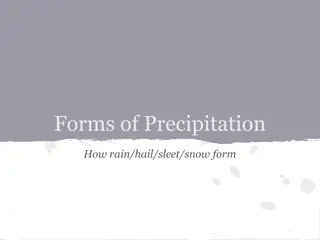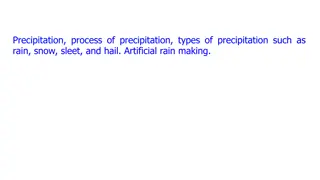Understanding Different Climate Types and Regions
The climate is shaped by temperature, precipitation, and wind, creating global patterns and diverse climate regions. From tropical wet climates to continental warm summers, each region has unique characteristics based on temperature and precipitation. By understanding these climate types, we can app
0 views • 7 slides
Hydrologic Modeling Methods in HEC-HMS: A Comprehensive Overview
Explore the transformative methods within HEC-HMS hydrologic modeling, including unit hydrograph derivation, excess precipitation transformation, hydrograph illustration, surface transform methods, and concepts like the kinematic wave and 2D diffusion wave. Learn about the unit hydrograph, kinematic
0 views • 41 slides
Advancing Radar Science: Open-Source Collaboration for Precipitation Estimation
Explore the innovative work presented at the Open Radar Science in SAIL conference featuring collaborative research, open-source tools like Py-ART and Xradar, and value-added products enhancing quantitative precipitation estimates. Learn about CMAC, SQUIRE, and other techniques for radar data proces
2 views • 10 slides
Insights into Raindrop Size Distribution and Precipitation Intensity through Radar Technology
Vertical momentum of impacting raindrops can be converted into an electric pulse to analyze raindrop size distribution. Disdrometers using video cameras can directly count raindrops for sizing. Radar technology provides superior data on precipitation accumulation and intensity by measuring radar ref
4 views • 9 slides
Understanding Precipitation and Rainfall Patterns in Hydrology
Exploring the various forms of precipitation like rainfall, snowfall, hail, and sleet, this lesson delves into the complexities of precipitation forms, intensity classifications, types of rain gauges, and methods for correcting deficiencies in rainfall data. Through detailed descriptions and images,
1 views • 39 slides
Understanding Tropical Cyclones: General Characteristics, Types, and Origins
Tropical cyclones, developed in the region between the tropics of Capricorn and Cancer, exhibit unique characteristics such as varying size and velocity. They primarily impact coastal areas, known for low pressure centers and lack of temperature variations. These cyclones are classified based on int
0 views • 15 slides
Understanding Precipitation in Meteorology
Precipitation in meteorology is the result of atmospheric water vapor condensing and falling to Earth, a vital element of hydrology. It can occur in liquid or solid forms through processes like evaporation, cooling, condensation, and droplet growth. Different geographic and climate conditions impact
0 views • 17 slides
Hydrologic Modeling with Gridded Precipitation Data
Learn about utilizing gridded precipitation data for hydrologic modeling with HEC-HMS. Explore the advantages of spatially distributed precipitation sources such as RADAR and gauge comparisons, and understand the various national and regional products available. Discover utilities for converting and
1 views • 14 slides
Understanding Precipitation in Pharmacy and Chemistry
Precipitation is a crucial process in chemistry and pharmacy, where solid particles are separated from a clear liquid solution. This method is used for various purposes like obtaining fine particles, purifying powders, and preparing pharmaceutical substances. Examples include calcium carbonate, ammo
7 views • 10 slides
Understanding Antigen-Antibody Precipitation Reaction in Microbiology
Antigen-antibody precipitation reaction involves the formation of insoluble products when a soluble bivalent antibody interacts with a soluble antigen. This reaction leads to the formation of a visible precipitate known as a lattice. The mechanism of precipitation, including the prozone phenomenon,
0 views • 20 slides
Understanding Precipitation Titration in Analytical Chemistry
Precipitation titration is a method where a precipitate is formed by converting one reacting species. An example is the estimation of chloride using AgNO3, where AgCl is precipitated. The titration is based on the formation of precipitates, and suitable conditions, indicators, and methods are vital
0 views • 30 slides
Understanding the Kӧppen Climate Classification System
The Kӧppen climate classification system, developed by Wladimir Kӧppen in 1884 and modified over the years, categorizes climates based on native vegetation as the best indicator. It recognizes five major climatic types designated by capital letters, reflecting temperature and precipitation pattern
0 views • 10 slides
Understanding Antigen-Antibody Interactions and Diagnostic Tests
Antigen-antibody interactions are essential in immunology, determining disease presence, blood types, and more. Diagnostic tests such as agglutination and precipitation reactions play a crucial role. Specimen collection involves obtaining blood samples for analysis, while precipitation reactions for
0 views • 22 slides
Contractions of Tropical Precipitation Under Global Warming
Aaron Donohoe's research focuses on the contraction of tropical precipitation with global warming, emphasizing the zonal mean and its implications for climate models. The results show a robust contraction and intensification of tropical precipitation in a warmer world. The width of tropical precipit
0 views • 12 slides
Insights into Precipitation Analysis for Transportation Applications
Delve into the utilization of precipitation data by state transportation agencies for road and bridge design, safety operations, and traveler information. Explore model components and the nature of precipitation events, along with challenges associated with spatial scale sampling. Discover the impor
4 views • 12 slides
Understanding Extra-Tropical Cyclones and Anticyclones
Extra-Tropical Cyclones (ETC) occur outside tropical regions and are associated with fronts, unlike hurricanes. The Norwegian Cyclone Model explains the lifecycle of ETCs, starting at the polar front and describing cyclogenesis through wind shear patterns.
2 views • 75 slides
Impact of Precipitation on Ocean Salinity: Study at University of Antananarivo
Juliette Soanaoly from the University of Antananarivo presents a study on the impact of precipitation on ocean salinity. The research explores the intercorrelation between rainfall and salinity, variability of precipitation in a specific study area, and the methodologies used to analyze the data ove
1 views • 17 slides
Collaborative Science and Operations Officer in Albany, New York
Warren R. Snyder is the Science and Operations Officer at the Weather Forecast Office in Albany, New York. He is actively involved in the Collaborative Science, Technology, and Applied Research (CSTAR) program, which aims to bridge NWS-supported activities with the academic community. The program fo
0 views • 10 slides
Effects of Down-Valley Flow on Precipitation Patterns and Microphysics
Down-valley flow in complex terrain areas like the Alps and British Columbia modifies precipitation patterns through diabatic cooling and melting effects. Observations from the OLYMPEX field campaign show how down-valley flow is influenced by both thermodynamics and pressure gradients, with signific
0 views • 15 slides
Protein Denaturation and Precipitation: Mechanisms and Effects
Protein denaturation is a process where proteins lose their native structure due to external factors like heat, strong acids, or bases. This leads to protein aggregation and precipitation. Different types of denaturation exist, including reversible and irreversible forms. Strong mineral acids can al
1 views • 21 slides
PREDICT: Pre-Depression Investigation of Cloud Systems in the Tropics
PREDICT is an NSF project focusing on investigating tropical cloud systems to better understand tropical cyclone formation. It builds on previous field campaigns and modeling activities, aiming to test hypotheses, explore different genesis pathways, and advance our understanding of the processes inv
0 views • 10 slides
Forms of Precipitation and How They Form
Precipitation is any form of water that falls to earth and occurs when water evaporates into the atmosphere, saturates it, then condenses back into water. There are 5 main types of precipitation: rain, sleet, hail, snow, and freezing rain. Rain forms as water droplets in clouds collide and grow too
1 views • 14 slides
Understanding Climate Classification Systems
Climatology explores the classification of climates based on vegetation distribution, average temperatures, precipitation patterns, and seasonal variations. This system categorizes climates into groups like tropical, dry, mild temperate, continental, and polar. Each group further delineates specific
0 views • 8 slides
Unstable Weather Alert: Tropical System Impact and Shear Line Approaching
Tropical system passing north, bringing heavy rainfall and unstable air. Expect convective showers, tailwinds on landing, and shifting precipitation patterns. Concerns about tropical showers, moisture levels, and shear line impact on landing and takeoff conditions. Images of weather situations provi
1 views • 10 slides
Understanding Precipitation: Forms and Types Explained
Precipitation, any form of moisture reaching Earth's surface from the atmosphere, encompasses various types like rain, snow, drizzle, glaze, sleet, and hail. Each type has unique characteristics, densities, and formation processes. Additionally, precipitation can be classified into convection, cyclo
1 views • 38 slides
Advances in Tropical Cyclone Radar Rainfall Estimation
Reviewing past methods and introducing new tools for radar rainfall estimation in tropical cyclones. Discusses advancements in Dual Polarization rainfall estimation and NSSL's National Mosaic & Multi-Sensor Quantitative Precipitation Estimation. Includes insights on reflectivity-to-rainfall relation
0 views • 28 slides
Understanding Precipitation: Process, Types, and Artificial Rain Making
Precipitation occurs through the condensation of water vapors in the air. The process involves various types such as rain, snow, sleet, and hail, each formed differently - convectional, orographic, and frontal/cyclonic. Learn about the mechanisms behind precipitation, including the creation of artif
1 views • 25 slides
Understanding Cloud and Precipitation Processes in Atmospheric Science
This week's module focuses on measuring, predicting, and modeling single-column processes related to clouds and precipitation. Topics covered include ODE and PDE models, advection equations, orographic clouds, warm and cold cloud processes, condensation, warm-rain processes, and more. The importance
0 views • 17 slides
Advancing Research and Innovation in Neglected Tropical Diseases and Forensic Biotechnology at Ahmadu Bello University, Zaria
The Africa Center of Excellence on Neglected Tropical Diseases and Forensic Biotechnology (ACENTDFB) at Ahmadu Bello University in Zaria is focused on upgrading its facilities, expanding research units, and establishing advanced laboratories to address global health challenges. Strategic objectives
0 views • 11 slides
Enhancing Precipitation Interpolation Methods for High-Resolution Data Analysis
Accurate interpolation of precipitation data is crucial for various applications, especially in regions with limited data coverage like Greece. This study focuses on improving the creation of a precipitation atlas for Greece using daily observation analysis. By analyzing the reliability of the metho
0 views • 24 slides
Estimation of Precipitation over the OLYMPEX Domain during Winter 2015-2016
The study aims to evaluate precipitation products over the OLYMPEX domain during the winter of 2015-2016 by utilizing various data sources such as NOAA, NASA, and in-situ observations. The primary goal is to enhance the assessment of Global Precipitation Mission (GPM) products, focusing on regions w
0 views • 22 slides
Diagnosing Low-Topped Precipitation Events Using Satellite Imagery
Utilizing MODIS/VIIRS Night-Time Microphysics RGB Imagery combined with Proximity Soundings can enhance situational awareness and aid in diagnosing low-topped precipitation events. Various satellite images and data sources are analyzed to understand why heavy rain occurred in Havre, MT, despite mini
0 views • 17 slides
Understanding Global Ecosystems and Tropical Rainforests
Ecosystems exist at various scales, influenced by both living and non-living components. Global atmospheric circulation shapes the distribution of biomes like tropical rainforests and hot deserts. Tropical rainforests, with distinct environmental characteristics, face threats like deforestation. Sus
0 views • 15 slides
Understanding Antigen-Antibody Precipitation Reaction in Immunity
The humoral basis of immunity involves the specific reaction between antigens and antibodies, resulting in the formation of insoluble precipitates through a process called precipitation. This reaction plays a crucial role in immune responses against infectious diseases, influenced by factors like af
0 views • 16 slides
Improvements in Statistical Tropical Cyclone Forecast Models Update
This update discusses improvements in statistical tropical cyclone forecast models as part of the Year 2 Joint Hurricane Testbed Project. It covers tasks such as extended range baseline models, updating databases, and trajectory approaches for baseline models. The project aims to enhance the accurac
0 views • 19 slides
Protein Purification Techniques and Ammonium Sulfate Precipitation
Protein purification is a crucial process in biotechnology to isolate specific proteins from complex mixtures. Techniques such as exploiting physio-chemical properties, binding affinity tags, and biological activity are used. Ammonium sulfate precipitation, a common first step, involves adding incre
0 views • 60 slides
Impressive Impact of Recent El Niño-Fueled Storms in San Diego County
El Niño-driven storms in San Diego County led to above-average winter precipitation, with areas receiving over 5 inches of rain in just 3 days. This sudden increase has significantly boosted accumulated precipitation levels for the winter, especially in Southern California. The rapid rise in precip
1 views • 5 slides
Increase in Precipitation Efficiency with Surface Warming
The study examines how surface warming affects precipitation efficiency in radiative-convective equilibrium. Various factors influencing precipitation efficiency, such as microphysical processes and climate sensitivity, are discussed. Model experiments are conducted to test the sensitivity of precip
0 views • 33 slides
Understanding Tropical Cyclones and Layers of the Atmosphere
Tropical cyclones are warm-core low-pressure systems that form over oceans with high sea surface temperatures. The Philippines is prone to these cyclones, leading to heavy rains, flooding, and strong winds. The layers of the atmosphere, from the exosphere to the troposphere, play crucial roles in sh
0 views • 7 slides
Methods for RNA Purification and Separation from DNA
Selective precipitation of RNA using Lithium Chloride (LiCl) and extraction with phenol at acidic pH are two common methods for separating RNA from DNA. LiCl forms a complex with RNA facilitating its precipitation, while acidic phenol solution helps stabilize RNA at pH 4-5 for extraction. TRIzol var
0 views • 7 slides







































